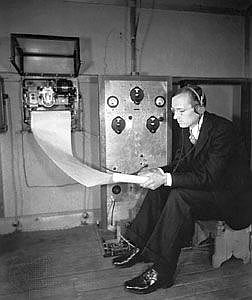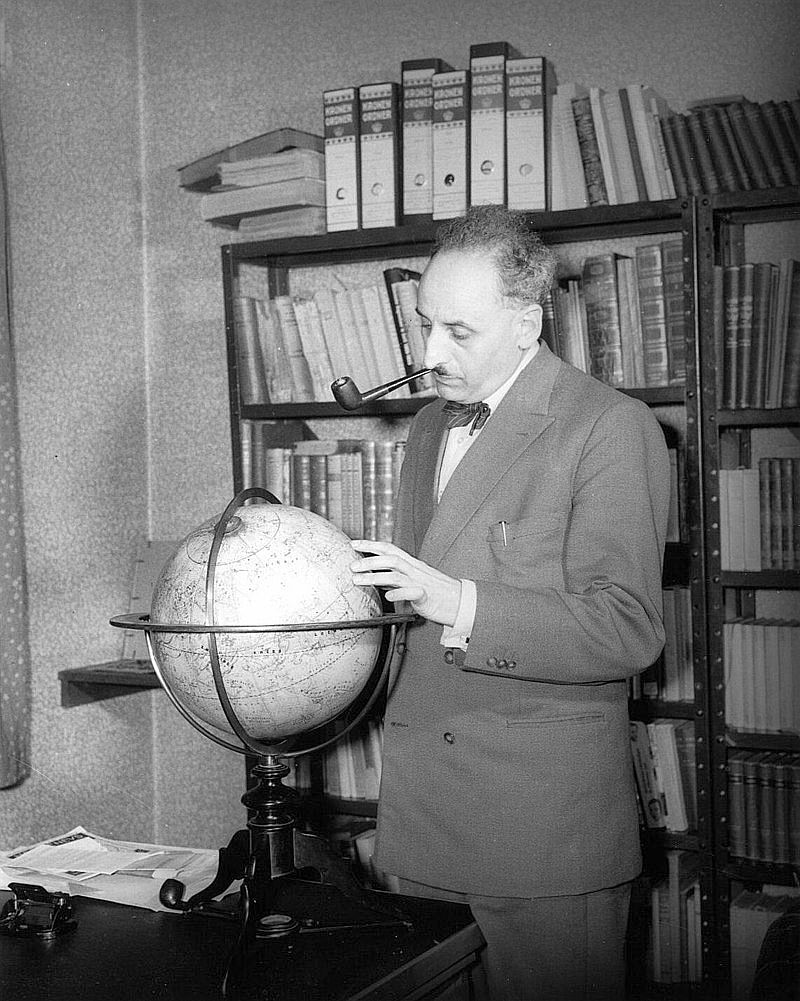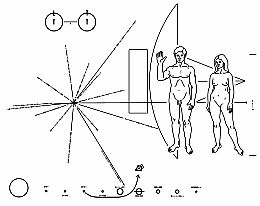In 1932, Karl Jansky serendipitously observed radiation coming from the Milky Way at Bell Labs, thereby inaugurating the science of radio astronomy. By this point, the evidence that humans were the only intelligent species in the solar system was mounting, but Jansky’s breakthrough turned the entire galaxy into fertile hunting grounds for extraterrestrial life. In the decades since Jansky’s discovery, radio astronomers have yet to detect so much as a simple beacon indicating that there is intelligent life elsewhere in our galaxy, but this didn’t stop scientists from proactively addressing the troubling problem foreseen by Tesla: how to exchange ideas with extraterrestrials once contact was established.

Astraglossa
In 1952, the experimental zoologist Lancelot Hogben stood before the British Interplanetary Society and outlined his plan for a cosmic language called the Astraglossa1. Although he later admitted that the project was a “jeu d’esprit for an evening’s entertainment,” he noted that it nevertheless “had an undertone of serious intention”.
Hogben’s presentation marked the beginning of a “symbolic turn” in the field of interstellar communication, which continues to dominate the field to this day. E.g. given that an extraterrestrial recipient cannot be presumed to know anything about the conventions of communication systems on Earth, the new METI systems adopted self-interpretation as a guiding principle. The messages would have to be able to explain themselves, as it were, which would require beginning with knowledge that can reasonably be assumed to be universal. Next encoding this knowledge in a symbol system. Finally using this symbol system to build increasingly complex statements.
Hogben’s Astraglossa, for example, sought to build a radio lexicon and syntax by using numbers as a basis for the discussion of astronomical phenomena known to both the sender and receiver, such as the relative position of the planets in the recipient’s solar system.
Lincos
In 1960, the same year that Frank Drake inaugurated modern SETI with Project Ozma, the Dutch mathematician Hans Freudenthal published Lincos: Design of a Language for Cosmic Intercourse. Although Freudenthal’s system bears a remarkable similarity to Hogben’s Astraglossa, neither appears to have been aware of the other’s work prior to publication and Lincos is generally considered to be the first fully developed symbolic communication system for interstellar communication.

Fourteen years after Freudenthal published Lincos, Frank Drake and Carl Sagan sent the first interstellar message from the Arecibo telescope in Puerto Rico to a star cluster approximately 22,000 light years from Earth. Rather than adopt Freudenthal’s Lincos, which Drake considered to be a “rather risky method for interstellar communication, because it assumed that the recipients have brains and logic very similar to ours,” Drake and Sagan instead chose what they considered to be a “simpler unambiguous method”. Although it was the most powerful radio transmission ever sent into space for the purposes of interstellar communication, the Arecibo message was more about demonstrating the technological capacity of new instruments on the Arecibo telescope than an earnest attempt at establishing interstellar communication.
Voyager missions
Three years after this historic broadcast, two probes left Earth on a journey to the edge of the solar system. The Voyager missions launched about two weeks apart in 1977, each carrying a golden record designed as a sort of time capsule to represent life on Earth. Created by a committee chaired by Sagan, the records contain a diverse collection of visual and audio content, including:
- 115 images from Earth,
- field recordings of everything from the ocean surf to bird song,
- musical selections ranging from Bach to Chuck Berry,
- an hour’s worth of brainwaves collected from the committee’s creative director Ann Druyan,
- a diagram of the hydrogen molecule, and
- a recording of Sagan laughing.
Pioneer 10 plaque
On March 3, 1972, the Pioneer 10 spacecraft was launched from Cape Kennedy. Pioneer 10 was the first space vehicle designed to explore the environment of the planet Jupiter and, earlier in its voyage, the asteroids that lie between the orbits of Mars and Jupiter. It approached Jupiter on December 3, 1973, and then was accelerated by Jupiter’s gravity to become the first man-made object to leave the Solar System. Its exit velocity is about 7 miles per second.
Small plaques (a 6 by 9-inch gold-anodized aluminum plate) had been affixed to the Pioneer 10 and 11 probes, which depicted a nude man and woman, as well as a map of our solar system to show the origin of the spacecraft.

The content of the message on the plaque should be clear to an advanced extraterrestrial civilization, which will, of course, have the entire Pioneer 10 or 11 spacecraft to examine as well. The message is probably less clear to the man on the street, if the street is on the planet Earth. However, scientific communities on Earth have had little difficulty decoding the message.
The opposite is the case with the representations of human beings to the right. Extraterrestrial beings, which are the product of 4.5 billion years or more of independent biological evolution, may not at all resemble humans, nor may the perspective and linedrawing conventions be the same there as here. The human beings are the most mysterious part of the message. More about the impact of the plaque in Exterrrestrial 8!
Congress stops SETI efforts
By the early 1990s, publicly funded SETI (Search for Extraterrestrial Intteligence) programs were dead thanks to the efforts of several US congressmen who objected to using taxpayer dollars to search for “little green men with misshapen heads,” but this didn’t stop research on the design of interstellar messages.
Copple’s Ella
In 2003 nevertheless, a Cosmic Call message was sent from Yevpatoria2 to five different stars within 46 light years of Earth. This Cosmic Call transmission included the binary code for a rudimentary chatbot named Ella. Created by the computer programmer Kevin Copple in 2000, Ella represented the epitome of natural language processing at the time. She can crack jokes, play blackjack, and if Copple gets his way, she will also be the first interstellar ambassador for Earth, assuming that the extraterrestrials on the receiving end of the message can figure out how to run the software.
Astrolinguistics
In terms of symbolic systems for interstellar communication, the most significant advance in the field in the past half century was the publication of Astrolinguistics by the Dutch mathematician Alexander Ollongren in 2013. The text is essentially a second-generation version of Freudenthal’s Lincos that applies recent developments in computer science to the problem of interstellar communication. Aside from Lincos, it is the only other fully fledged language (that is, one consisting of a robust syntax and semantics) that has been designed for the sole purpose of communicating with extraterrestrials.
1 Astraglossa is an essay describing a system for combining numbers and operators in a series of short and long pulses. In Hogben’s system, short pulses represent numbers, while trains of long pulses represent symbols for addition, subtraction, etc.
2 The Yevpatoria RT-70 is a radio telescope and planetary radar at the Center for Deep Space Communications, Yevpatoria, Russia. In the scientific literature is often called Evpatoria Planetary Radar (EPR).